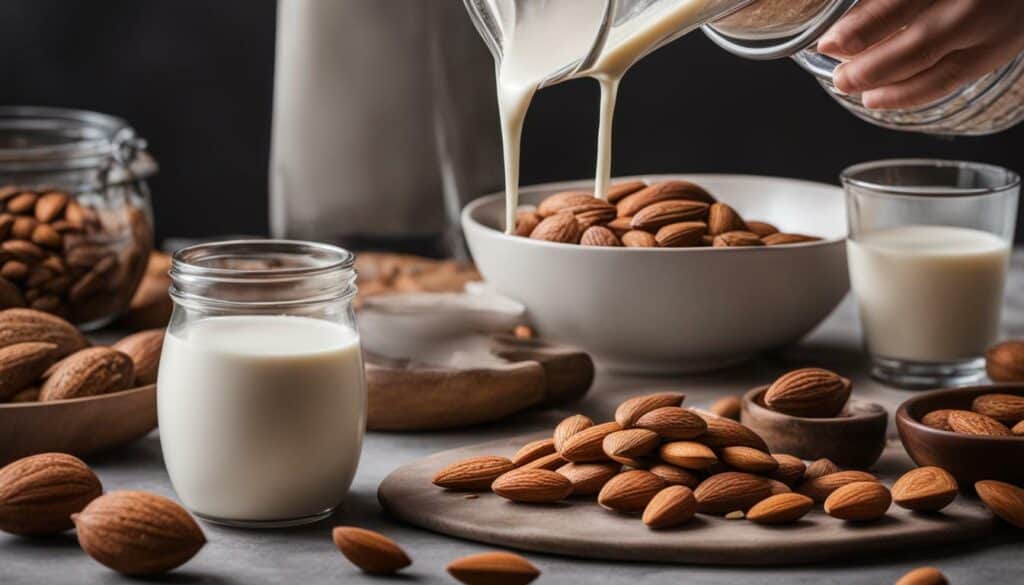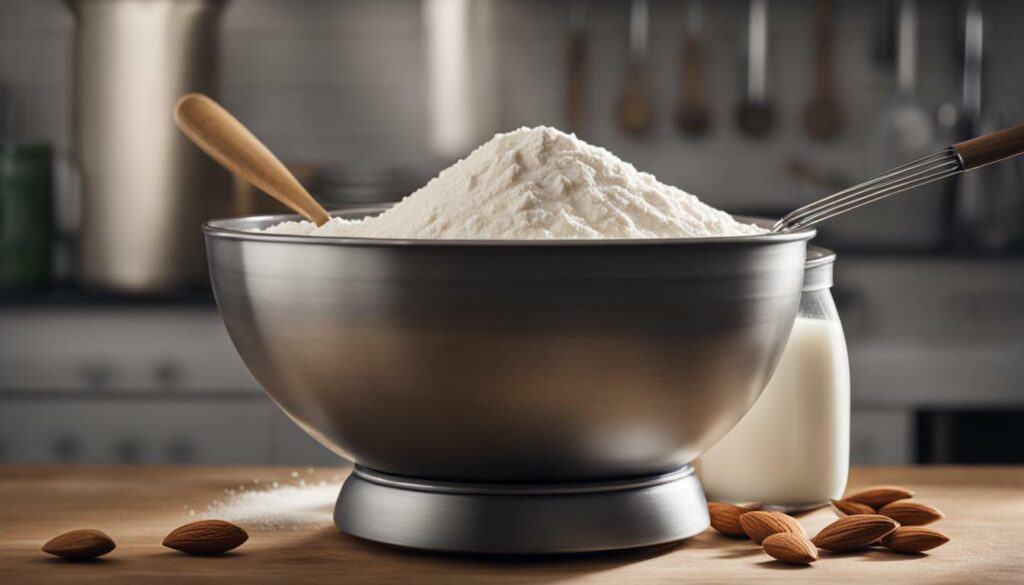Have you ever wondered if you can elevate your baking game by using almond milk instead of traditional cow’s milk? The answer is a resounding yes! Almond milk is not only a delicious and sustainable alternative, but it can also be used in a wide range of recipes to create delectable treats.
Almond milk can be used as a 1:1 replacement for cow’s milk in most baking recipes. Whether you’re making cookies, cakes, muffins, pancakes, or even savory dishes like garlic bread and hummus, almond milk can easily be incorporated into your favorite recipes. Its creamy texture and nutty flavor add a delightful twist to your baked goods.
Key Takeaways:
- Almond milk can be used as a substitute for cow’s milk in baking recipes.
- It can be used in a wide variety of baked goods, from cookies to savory dishes.
- When using almond milk for baking, heat it gently to prevent curdling.
- Almond milk has a creamy texture and a nutty flavor that adds a unique touch to your creations.
- Almond milk offers several health benefits, such as being low in calories and saturated fat.
Baking with Almond Milk: A Dairy-Free Delight
Baking with almond milk opens up a world of possibilities for those who prefer to avoid dairy or are following a plant-based diet. Almond milk is a delicious and sustainable alternative to cow’s milk, making it a great option for dairy-free baking. Whether you’re whipping up a batch of cookies or baking a cake, almond milk can be used as a 1:1 replacement for cow’s milk in most recipes.
“Almond milk can be a tasty and sustainable substitute for traditional cow’s milk in baking.”
Not only does almond milk provide a creamy texture and nutty flavor to your baked goods, but it also offers several health benefits. It is low in calories and saturated fat, making it a lighter option for those who are watching their waistline. Additionally, almond milk may help to lower cholesterol levels, making it a heart-healthy choice for your baking endeavors.
When using almond milk for baking, it’s important to heat it gently and avoid boiling it to prevent curdling. This gentle heating process helps to ensure that the almond milk integrates seamlessly into your recipes, resulting in moist and flavorful baked goods. Almond milk can be used in a wide variety of recipes, from sweet treats like cookies and cakes to savory dishes like garlic bread and hummus. Its versatility knows no bounds!
Benefits of Baking with Almond Milk:
- Perfect for those with lactose intolerance or dairy allergies
- Offers a lighter and healthier alternative to cow’s milk
- Provides a creamy texture and nutty flavor to baked goods
- Can be used in a wide range of recipes, both sweet and savory
- May help to lower cholesterol levels and promote heart health
So why not give almond milk a try in your next baking venture? With its delectable taste and numerous health benefits, it’s sure to become a staple in your kitchen. Embrace the dairy-free delight of almond milk and let your creativity soar!
The Versatility of Almond Milk in Baked Goods
Almond milk can be seamlessly incorporated into a wide range of baked goods, from fluffy cakes to crispy cookies. Its creamy texture and nutty flavor add a delightful twist to traditional recipes, making it a popular choice for those seeking dairy-free alternatives. Whether you’re following a vegan lifestyle or simply looking to switch things up in the kitchen, almond milk offers a versatile and delicious option for your baking adventures.
One of the great advantages of using almond milk in baking is its ability to act as a 1:1 substitute for cow’s milk. This means that you can easily replace traditional milk with almond milk in your favorite recipes without making any adjustments. Whether you’re whipping up a batch of chocolate chip cookies or preparing a moist chocolate cake, almond milk can provide the same moisture and richness that cow’s milk offers.
Not only does almond milk work well in sweet treats, but it also lends itself beautifully to savory dishes. You can use almond milk as a substitute for milk or cream in recipes like garlic bread, creamy dips, or savory bread puddings. Its subtle nutty flavor enhances the overall taste and texture of these dishes, giving them a unique and delicious twist.
Almond Milk Substitutes in Baking
When using almond milk in your baking, keep in mind a few tips to ensure the best results. First, it’s important to gently heat your almond milk and avoid boiling it. Heating it too quickly or to a high temperature can cause it to curdle and affect the texture of your baked goods. Additionally, you may find that almond milk has a slightly thinner consistency compared to cow’s milk, so consider adjusting the amount of liquid in your recipe accordingly.
Finally, don’t limit yourself to just baking with almond milk. This versatile dairy-free alternative can be used in many other culinary creations. Use it to make creamy smoothies, add a splash to your morning coffee, or create a delicious almond milk-based sauce to drizzle over your favorite dishes. The possibilities are endless.
| Baked Goods | Almond Milk Substitution Ratio |
|---|---|
| Cakes | 1 cup cow’s milk = 1 cup almond milk |
| Cookies | 1 cup cow’s milk = 1 cup almond milk |
| Muffins | 1 cup cow’s milk = 1 cup almond milk |
| Pancakes | 1 cup cow’s milk = 1 cup almond milk |
So, if you’re curious about experimenting with new flavors and exploring dairy-free alternatives, give almond milk a try in your next baking adventure. Its versatility and delicious taste are sure to impress, and you’ll be pleasantly surprised by the wide range of baked goods and culinary creations you can make with this nutty delight.

Transform your classic cake and cookie recipes into delightful almond-infused creations with these simple substitutions. Almond milk can be used as a dairy-free alternative in a wide range of baking recipes, adding a nutty flavor and creamy texture to your favorite treats. Whether you’re following a vegan diet, have lactose intolerance, or simply want to try something new, almond milk is a versatile and delicious option.
When using almond milk in cake recipes, simply replace the cow’s milk with almond milk in a 1:1 ratio. The almond milk will add a subtle sweetness and moistness to the cake, making it even more indulgent. For cookie recipes, you can also use almond milk as a substitute for cow’s milk, resulting in a delicate and nutty flavor. The possibilities are endless, from almond milk chocolate chip cookies to almond milk-infused carrot cake.
| Classic Recipe | Almond Milk Substitute |
|---|---|
| Vanilla Cake | Vanilla Almond Milk Cake |
| Chocolate Chip Cookies | Almond Milk Chocolate Chip Cookies |
| Blueberry Muffins | Almond Milk Blueberry Muffins |
Not only does almond milk add a unique flavor profile to your baked goods, but it also offers health benefits. Almond milk is low in calories and saturated fat, making it a lighter and healthier option compared to cow’s milk. It may also help in reducing cholesterol levels, making it a good choice for those looking to improve their heart health. So why not experiment with almond milk in your baking and discover a whole new world of delicious possibilities?

Embrace the nutty goodness of almond milk in your baking journey and elevate your cakes and cookies to a whole new level of deliciousness. Whether you’re a seasoned baker or a novice in the kitchen, almond milk is a versatile ingredient that will impress your taste buds and those of your loved ones. So go ahead, give it a try, and infuse your baked goods with the delightful flavor and creamy texture of almond milk. Happy baking!
Tips for Baking with Almond Milk
To achieve the best results when baking with almond milk, follow these handy tips and tricks to ensure a mouthwatering outcome.
- Choose unsweetened almond milk: Opt for unsweetened almond milk when using it in baking. This will allow you to have better control over the sweetness of your final product.
- Adjust for thickness: Almond milk is typically thinner than cow’s milk, so you may need to slightly increase the amount of almond milk in your recipe or add a thickening agent, such as a tablespoon of cornstarch or arrowroot powder, if needed.
- Be mindful of flavor: Almond milk has a subtle nutty flavor that can enhance certain baked goods, but it may not complement every recipe. Consider the flavor profile of your dish and how almond milk will contribute to it before making the substitution.
If you’re new to baking with almond milk, start by experimenting with simple recipes that don’t rely heavily on the structure or texture provided by cow’s milk. This will give you an opportunity to familiarize yourself with how almond milk performs in the oven and how it affects the taste and texture of your favorite treats.
Table: Baking with Almond Milk Substitutions
| Cow’s Milk | Almond Milk |
|---|---|
| 1 cup | 1 cup |
| 1/2 cup | 1/2 cup |
| 1/4 cup | 1/4 cup |
| 1 tablespoon | 1 tablespoon |
Remember, almond milk can curdle if heated too quickly or at high temperatures. To prevent this, warm it gently over low heat or use it at room temperature in recipes that don’t require heating.
So go ahead and embrace the versatility of almond milk in your baking journey. Whether you’re looking for a dairy-free alternative or simply want to try new flavors, almond milk can be a delightful addition to your favorite recipes. With these helpful tips in mind, you’ll be well on your way to creating tasty and satisfying treats that everyone can enjoy.

Don’t limit almond milk to just baking – discover how it can add a creamy and nutty touch to your favorite savory recipes. Almond milk’s versatility extends beyond sweet treats, opening up a world of possibilities in the kitchen. Whether you’re vegan, lactose-intolerant, or simply looking for a healthier alternative, almond milk can be a game-changer for your savory dishes.
When it comes to using almond milk in savory recipes, the possibilities are endless. From creamy soups to savory sauces, almond milk can enhance the flavor and texture of your dishes. It’s perfect for adding a rich and nutty element to classic recipes like garlic bread, mashed potatoes, and creamy sauces. The subtle sweetness and creamy consistency of almond milk can complement the savory flavors of roasted vegetables, pasta dishes, and even dips like hummus.
To give you a taste of the possibilities, here’s a quick and easy recipe for roasted garlic almond milk hummus:
Roasted Garlic Almond Milk Hummus Recipe:
- Preheat your oven to 400°F (200°C).
- Wrap a whole head of garlic in aluminum foil and roast it in the oven for about 30-40 minutes, until the cloves are soft and golden.
- In a food processor, combine a can of chickpeas, 2 tablespoons of tahini, the roasted garlic cloves, the juice of 1 lemon, 2 tablespoons of olive oil, ¼ cup of almond milk, and a pinch of salt and pepper.
- Blend until smooth and creamy.
- Transfer to a serving bowl and drizzle with olive oil.
- Serve with pita bread or fresh vegetables.
Give this recipe a try and explore the possibilities of almond milk in your savory dishes. Its creamy texture and nutty flavor can take your recipes to the next level, adding a unique twist that will delight your taste buds. So go ahead, get creative, and let almond milk elevate your culinary adventures!

Experience the delightful nuttiness and velvety texture that almond milk imparts to your baked creations. When used in baking, almond milk adds a unique flavor profile and a creamy richness that can elevate your favorite recipes. Whether you’re making cookies, cakes, muffins, or even savory dishes like garlic bread and hummus, almond milk can transform your culinary creations into delectable delights.
Almond milk has a distinct flavor that is subtly nutty, providing a pleasant depth of taste to your baked goods. Its creamy texture also contributes to the moistness and tenderness of your treats, ensuring a satisfying bite every time. Plus, almond milk is a great choice for those who follow a dairy-free or vegan lifestyle, as it offers a sustainable and cruelty-free alternative to cow’s milk.
In addition to baking, almond milk has a myriad of other uses in the kitchen. It can be enjoyed in a cup of coffee, blended into a creamy smoothie, or poured over a warm bowl of oatmeal for a nourishing breakfast. You can even incorporate almond milk into sauces and dressings, adding a rich and velvety consistency to your savory dishes.
| Benefits of Almond Milk in Baking |
|---|
| • Adds a delightful nuttiness to your recipes |
| • Provides a creamy and moist texture |
| • Suitable for dairy-free and vegan lifestyles |
| • Versatile ingredient for both sweet and savory dishes |
So go ahead, embrace the nutty goodness of almond milk in your baking adventures. Whether you’re a seasoned baker or just starting out, almond milk can open up a world of endless possibilities in the kitchen. Get creative, try new recipes, and discover the joy of using almond milk as a delicious and sustainable alternative. Your taste buds will thank you!

“I never thought almond milk could make such a difference in my baked goods. The flavor is incredible, and the texture is so smooth and moist. It’s a game-changer!” – Sarah, avid home baker
“Almond milk has become a staple in my kitchen. Not only does it add a wonderful nutty taste to my recipes, but it also keeps them light and healthy. I can’t imagine baking without it!” – Mark, health-conscious foodie
Almond Milk: More Than Just a Baking Ingredient
Embrace almond milk’s versatility as it goes beyond baking, adding a touch of indulgence to your morning coffee, refreshing smoothies, and more. This plant-based milk alternative provides a creamy and nutty flavor that complements a variety of beverages and recipes. Whether you follow a dairy-free or vegan lifestyle or simply enjoy exploring new flavors, almond milk is a delicious and nutritious option to incorporate into your daily routine.
One popular way to enjoy almond milk is by adding it to your morning coffee. It creates a creamy and slightly sweet taste that perfectly complements the rich flavors of your favorite brew. Whether you prefer a latte, cappuccino, or a simple cup of black coffee, almond milk adds a delightful twist that will awaken your taste buds.
Smoothies are another excellent way to incorporate almond milk into your diet. Its creamy texture blends seamlessly with fruits, vegetables, and other ingredients, creating a refreshing and nutritious beverage. From classic combinations like banana and almond milk to more adventurous recipes featuring spinach, almond milk adds a subtle nutty flavor that enhances the overall taste experience.
Almond milk can also be used in a variety of sauces, such as creamy pasta sauces or dressings for salads. Its smooth and velvety consistency adds richness and depth to your culinary creations. Whether you’re whipping up a vegan Alfredo sauce or a tangy vinaigrette, almond milk can be a versatile ingredient that elevates the flavors of your dishes.

With its numerous uses and health benefits, almond milk is a pantry staple that can enhance your cooking and baking adventures. From comforting morning beverages to delicious sauces and dressings, almond milk offers a delightful touch of indulgence to your favorite recipes. So go ahead, embrace the versatility of almond milk and discover the endless possibilities it brings to your culinary creations.
Light and Healthy: Almond Milk’s Nutritional Benefits
Not only is almond milk a delicious dairy alternative, but it also boasts a range of health benefits that can contribute to a well-balanced diet. This plant-based milk is low in calories and saturated fat, making it a suitable option for those looking to maintain a healthy weight. Additionally, almond milk is naturally cholesterol-free, which can be beneficial for heart health. Studies have shown that consuming almond milk may help lower bad cholesterol levels, reducing the risk of heart disease.
Almond milk is also a good source of essential vitamins and minerals. It contains vitamin E, an antioxidant that helps protect the body against oxidative stress and supports healthy skin and hair. Furthermore, almond milk is fortified with vitamin D, a nutrient that plays a crucial role in bone health and immune function. By incorporating almond milk into your diet, you can easily increase your intake of these vital nutrients.
| Nutrient | Amount per 1 cup (240ml) |
|---|---|
| Calcium | 451mg |
| Vitamin E | 49% of the daily value |
| Vitamin D | 25% of the daily value |
Furthermore, almond milk is naturally lactose-free, making it an excellent option for individuals with lactose intolerance or milk allergies. It can be used as a substitute in various recipes, including smoothies, soups, and sauces, providing a creamy texture without the need for dairy. Whether you follow a vegan lifestyle or simply want to reduce your consumption of animal products, almond milk is a versatile and nutritious choice.
So why not give almond milk a try in your baking and cooking adventures? Not only does it add a delightful nutty flavor and creamy texture to your dishes, but it also offers numerous health benefits. From its potential role in cholesterol reduction to its abundance of essential vitamins and minerals, almond milk is a valuable addition to any well-rounded diet.

Take a leap into the world of plant-based baking and discover the wonders of almond milk for yourself. Whether you follow a vegan lifestyle or simply want to explore a dairy-free alternative, almond milk can be a game-changer in your baking endeavors. With its creamy texture and nutty flavor, almond milk adds a unique twist to your favorite recipes.

When it comes to incorporating almond milk into your baking, the possibilities are endless. You can use almond milk as a 1:1 replacement for cow’s milk in most recipes. From fluffy pancakes to moist cakes and chewy cookies, almond milk brings a delicate richness to your baked goods.
But it doesn’t stop there! Almond milk can also be a secret ingredient in savory dishes. Imagine a creamy garlic bread or a velvety hummus made with almond milk. The versatility of this plant-based milk knows no bounds.
Go Beyond Baking
Looking for more ways to use almond milk? It’s not just for baking! Try adding it to your morning coffee or smoothies for a dairy-free boost. Use it to create creamy sauces for pasta dishes or drizzle it over your favorite oatmeal. Almond milk is a versatile, plant-based ingredient that can elevate your culinary creations.
| Benefits of Almond Milk | Taste | Texture |
|---|---|---|
| Low in calories and saturated fat | Nutty and delicate | Creamy and smooth |
| Potential to lower cholesterol levels | Subtle and pleasant | Light and velvety |
Almond milk is a versatile and delicious dairy-free alternative for baking and other culinary pursuits. Its unique flavor and creamy texture can enhance both sweet and savory dishes, making it a must-have ingredient for plant-based bakers.
So, why not give almond milk a try in your baking journey? Embrace the wonders of this plant-based milk, and let your creativity flourish in the kitchen. With almond milk, you can create delectable treats that are not only dairy-free but also full of flavor. So go ahead, grab your apron, and start baking with almond milk today!
Almond Milk: A Revolution in Baking
Join the baking revolution and witness the magic unfold as almond milk breathes new life into your favorite recipes. Can you bake with almond milk? Absolutely! This versatile dairy-free alternative can be used as a 1:1 replacement for cow’s milk in most baking recipes. Whether you’re making cookies, cakes, muffins, or even savory dishes like garlic bread and hummus, almond milk adds a delightful nutty flavor and a creamy texture.
When incorporating almond milk into your baking, it’s essential to handle it with care. Gently heat the almond milk without boiling it to prevent curdling. This will ensure the perfect consistency in your baked goods. And don’t limit yourself to just baking! Almond milk can be used in various other culinary creations like coffee, smoothies, oatmeal, and sauces.
Aside from its delicious taste, almond milk also offers several health benefits. It’s naturally low in calories and saturated fat, making it a lighter alternative to cow’s milk. Additionally, almond milk may potentially help lower cholesterol levels. So, not only can you enjoy your favorite baked treats guilt-free, but you can also support your overall well-being.

In conclusion, almond milk is a game-changer in the world of baking. Its versatility, nutty flavor, and creamy texture make it a go-to choice for both sweet and savory recipes. So why not embrace this plant-based milk in your baking journey and explore the countless possibilities it offers? Try replacing cow’s milk with almond milk in your next baking adventure, and let the almond milk revolution unfold in your kitchen!
Conclusion
With its versatility and delightful flavor, almond milk truly revolutionizes the world of baking, offering a dairy-free alternative that is sure to please.
So, can you bake with almond milk? Absolutely! Almond milk can be substituted for cow’s milk in most recipes, allowing you to enjoy your favorite treats without the dairy. Whether you’re making cookies, cakes, muffins, or pancakes, almond milk can be used as a 1:1 replacement, providing a creamy and nutty flavor to your baked goods.
Not only is almond milk a great option for baking, but it can also be used in savory dishes like garlic bread and hummus. Its versatility extends beyond the world of baking, making it a valuable ingredient to have in your pantry. You can also incorporate almond milk into your morning coffee, refreshing smoothies, and comforting oatmeal, or use it as a base for creamy sauces.
Aside from its delicious taste, almond milk offers several health benefits. It is low in calories and saturated fat, making it a lighter option compared to cow’s milk. Additionally, almond milk has the potential to help lower cholesterol levels, further enhancing its appeal.
So, whether you follow a dairy-free or vegan lifestyle or simply want to try something new in your baking, almond milk is a fantastic choice. Its creamy texture, nutty flavor, and nutritional benefits make it a wonderful substitute for traditional cow’s milk. So go ahead and embrace almond milk in your baking journey – you won’t be disappointed!
FAQ
Q: Can almond milk be used as a substitute for cow’s milk in baking?
A: Yes, almond milk can be used as a 1:1 replacement for cow’s milk in most baking recipes.
Q: What types of baked goods can I make with almond milk?
A: Almond milk can be used in a wide variety of baked goods, including cookies, cakes, muffins, pancakes, and even savory dishes like garlic bread and hummus.
Q: How should I heat almond milk for baking?
A: It’s important to heat almond milk gently and avoid boiling it to prevent curdling.
Q: What does almond milk taste like?
A: Almond milk has a nutty flavor and a creamy texture, which adds a delightful twist to baked goods.
Q: Can almond milk be used in other recipes besides baking?
A: Absolutely! Almond milk can be used in coffee, smoothies, oatmeal, sauces, and more.
Q: Are there any health benefits to using almond milk in baking?
A: Almond milk is low in calories and saturated fat and may potentially help lower cholesterol levels, making it a healthier option for baking.
Q: Can almond milk be used for vegan baking?
A: Yes, almond milk is a great choice for vegan baking as it is a plant-based milk alternative.
Q: What are some tips for successfully using almond milk in baking?
A: Some tips include using it as a 1:1 replacement for cow’s milk, heating it gently, and adjusting the recipe if needed for desired consistency.
Q: How can I incorporate almond milk into my favorite recipes?
A: You can easily replace cow’s milk with almond milk in your favorite recipes, such as cake, cookies, and pancakes.
Q: Is almond milk versatile in both sweet and savory dishes?
A: Yes, almond milk can be used in both sweet and savory dishes, adding a unique flavor and creamy texture to recipes.
Can I Use Almond Milk in Meatball Recipes?
Almond milk can be a surprising but great alternative in meatball recipes. By substituting regular milk with almond milk, you can create moist and tender meatballs with a subtle, nutty flavor. Whether you’re making classic Italian meatballs or experimenting with different cuisines, including almond milk in your ingredients for a delicious meatball recipe can add a unique twist to your dish.






Leave a Reply